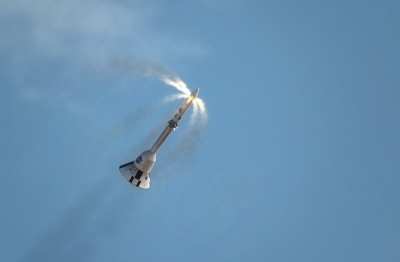Conversion Of Inert System Underway At ATK Facility In
Utah
The conversion of the main abort motor for NASA's first
Exploration Flight Test of the Orion Multi-Purpose Crew Vehicle,
slated for 2014 from Kennedy Space Center, is underway in Salt Lake
City, UT.

The inert system was recently returned to ATK's facility in Salt
Lake City from Lockheed Martin's Waterton facility in Denver, where
the system successfully completed a series of rigorous acoustic and
modal tests. The abort motor is part of Orion's Launch Abort
System, which is designed to safely lift the Orion crew module away
from the launch vehicle in the event of an emergency on the launch
pad or during initial ascent phase of NASA's Space Launch
System.
Standing more than 17 feet tall and measuring three feet in
diameter, the abort motor was manufactured in 2008. The motor is an
early prototype that was used to better understand the design and
to aid in the build-up and acoustic testing of the Orion capsule.
"In new developmental programs, we reduce risk by building an inert
prototype to better understand the design and manufacturing
processes," said Charlie Precourt, ATK General Manager and Vice
President of Space Launch Systems. "In the case of the abort motor,
it will now be reconfigured to support the first orbital test
flight of the Orion crew vehicle."
A few modifications will be incorporated into the abort motor,
including replacing the manifold with a flight design, performing
structural tests, adding case brackets for raceway and attachment
points for Orion's shroud, and adding flight instrumentation to
collect environmental and flight data during the test launch. "This
test flight is an extremely important milestone as we move forward
with America's new human exploration spacecraft and heavy-lift
launch system, enabling our human space flight program to conduct
missions beyond Earth's orbit," said Precourt.

The Orion, with its abort system, will fly aboard NASA's Space
Launch System, the rocket currently being developed to expand
America's capability in space exploration. The launch system will
be powerful enough to take crew and cargo into an orbit that
enables missions to the Moon, asteroids and eventually to Mars. In
addition to the main abort motor, ATK also makes the Attitude
Control Motor for the abort system at its Elkton, Md.
facility. The control motor provides steering for the launch
abort vehicle during an abort sequence. The control motor to
be used on EFT-1 is an inert motor also delivered in 2008, but
requires no modifications for the flight test.
The launch abort system sits at atop the Orion spacecraft and
was successfully tested during Orion's Pad Abort-1 flight test in
2010. The abort motor operational design utilizes a composite case
and titanium manifold exhaust turn-flow technology, resulting in
weight savings and improved performance. The control motor design
includes eight proportional-valve thrusters with a redundant
control system, which provide unparalleled control and safety.
 NTSB Final Report: Cessna 177B
NTSB Final Report: Cessna 177B ANN's Daily Aero-Term (05.08.25): Final Approach Fix
ANN's Daily Aero-Term (05.08.25): Final Approach Fix Aero-News: Quote of the Day (05.08.25)
Aero-News: Quote of the Day (05.08.25) ANN's Daily Aero-Term (05.09.25): Estimated (EST)
ANN's Daily Aero-Term (05.09.25): Estimated (EST) ANN's Daily Aero-Linx (05.09.25)
ANN's Daily Aero-Linx (05.09.25)




